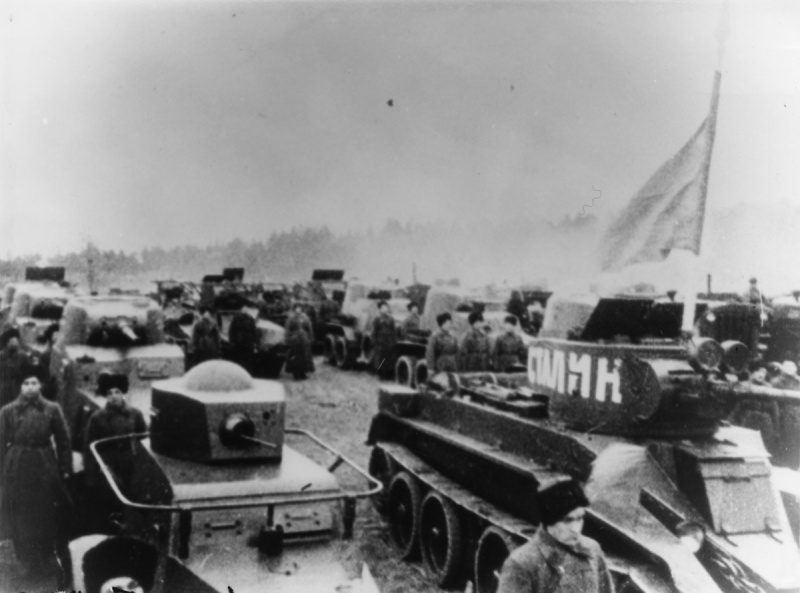
Another act of the Polish drama began on 17 September 1939 together with the invasion of Soviet Russia. In this way Stalin fulfilled his obligation to his German ally and actively joined the partition of the Second Polish Republic.
On September 1st Poland already found itself in a precarious military situation, semi-surrounded with difficult to defend borders. The attacking German armies had a field day, approaching from East Prussia and Slovakia. Looking at a map, every strategist would be quick to point out that under such circumstances a meaningful defence of West Poland is practically unattainable and the only sensible solution would be to withdraw major tactical units beyond the Vistula and consolidate defences there. Unfortunately, for political reasons, such a solution was unacceptable for the Polish government, as there was a worry that the Third Reich will occupy the undefended Wielkopolska, Pomerania and Silesia and then announce a peaceful annexation of these areas, just as it had done previously in Austria and Czechoslovakia. Tight at the outset of the war, the Polish armies were exposed to a powerful German encircling push.
Auxiliary units, stores, sites for forming rear-echelon units and to regroup decimated troops pulled back from the front line were left behind in the east. The Polish doctrine for continuing a defensive war identified areas to the east of the river Bug as the staging area from which to conduct further war efforts. With few urban centres, negligible road infrastructure, heavily forested and with inaccessible marches in abundance these areas were much better suitable for defence than Wielkopolska for example. The Romanian Bridgehead with access to Romanian and Hungarian borders played an important role in this doctrine. There was hope that if the Bridgehead was held, weapons and munitions could be transported from Black Sea ports.
However, all these calculations went down the drain on September the 17th, when Soviet Russia attacked. The Soviets were carrying out their obligations stemming from their pact with Hitler, even though the invasion was dressed up as a measure to help the peoples of West Ukraine and Belarus. The Commander-in-Chief of Poland's armed forces issues an order, which is being questioned and criticised to this day, not to fire at the Soviets. That order reached the relevant units, disorienting commanders and troops. Despite this confusion and overwhelming Soviet forces, Polish units still resisted. Border Protection Corps were the ones to take on the brunt of the fighting, the defence of Grodno is now legendary, seamen of the Pinsk Flotilla, unable to pull back their vessels scuttled them and continued to fight as infantry in General Kleberg's Operational Group. Such uncoordinated resistance could hardly hinder the advance of the Red Army. 17th of September also marked the beginning of Polish martyrology in the east. Immediately after entering East Poland, the Soviets began perpetrating atrocities against Poles, where Polish Army soldiers, policemen, officials as well as civilians suffered alike. Over the coming months and years, these repressions became systematic, with the Katyń massacre and deportations of hundreds of thousands of Poles to Siberia and Kazakhstan assuming symbolic roles in Polish national consciousness.
Under pressure from two enemies, the Polish civilian and military authorities fled from the county with the hope of continuing the struggle from abroad. Thousands of military and civilian refugees followed in their footsteps.
Whole units were retreating to Hungary, hoping to fight on with the support of the Allies. The Yablunytsia Pass was the main border crossing site. The 10th Motorized Cavalry Brigade commanded by Colonel Stanisław Maczek was one of the units which crossed the Hungarian border in order and with their remaining equipment. There were also smaller units as well as individual soldiers. Thousands of civilians also went with that way. All in all, in autumn of 1939, there were approximately 140 thousand Polish citizens in Hungary. The soldiers did their best to reach Polish Armed Forces which were being formed in the West. By and large Hungarians did not oppose this and thousands of officers and soldiers found their way to the recreated Polish Army. Some civilian refugees also made their way to the West during World War II, reaching France, England and even the USA and South America. Others remains in Hungary until the end of the war. The fates of thousands of Poles for years living in Hungary, their contacts with Poland and the government in exile (London), the efforts of schools and cultural institutions as well as the help provided of Hungarians – well, that's another subject.
.
M.B
